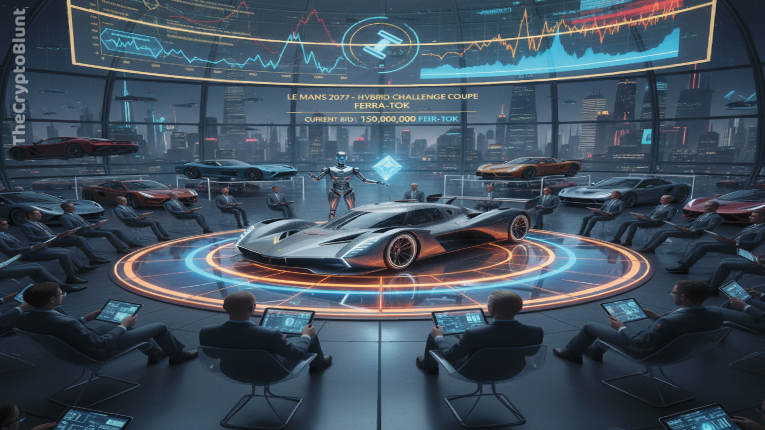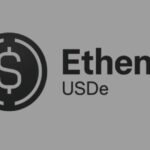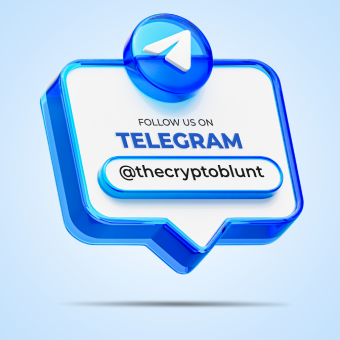Ferrari’s newest blockchain endeavor looks sleek on the surface; however, beneath the carbon fiber exterior, very little actual cryptocurrency functionality is present.
Ferrari is making an entry into the crypto sphere, exclusively for its top patrons. The famed Italian car manufacturer intends to release a “Token Ferrari 499P” that its one hundred most valued clients can utilize when submitting bids on a Le Mans-winning endurance vehicle.
This initiative represents a polished intersection of luxury and blockchain, where a portion of Ferrari’s heritage is owned through digital assets. Yet, beneath the extravagance, a more critical inquiry emerges: does this generate substantial Bitcoin or Ethereum movement, or is this merely a staged display of crypto integration?
Luxury Moves On-Chain — But Stays Exclusive
Ferrari’s involvement with cryptocurrency is not a recent development. In 2023, Bitcoin, Ethereum, and USDC began being accepted for vehicle acquisitions, with BitPay handling the process and converting funds instantly into fiat currency. The corporation never actually retained any digital assets; the endeavor amounted to more of a payment novelty than a genuine liquidity milestone.
The impending 499P vehicle auction adheres to the established procedure. The event is administered in collaboration with Conio, a fintech company, following EU MiCA regulations, and is limited solely to Ferrari’s exclusive “Hyperclub,” which comprises approximately one hundred pre-screened affluent individuals.
While this exclusivity aligns perfectly with the Ferrari brand, it simultaneously constrains the function of cryptocurrency. Bids will almost certainly be financed using Euros or pre-approved stablecoins that have passed KYC verification, rather than acquiring new ETH from open exchanges.
The overall transaction process is retained off-chain unless the fintech firm, Conio, mandates cryptocurrency deposits or completes settlement directly on public ledger systems. The probable outcome: an elegant, fully compliant, and nearly invisible record of the transfer is produced.
Provenance and Liquidity in Focus
Proponents of tokenization assert that it can transform non-liquid prize assets into viable, exchangeable investment opportunities. Through fractional ownership, small portions of artwork, vehicles, or unique collectibles, once exclusive to the extremely wealthy, are made available for purchase by investors.
In theory, a scarce Ferrari model could be segmented into digital equities that are traded around the clock and potentially even serve as security for loans. Blockchains simultaneously embed details concerning origin, serial identifiers, ownership records, and authentication data, a feature highly valued in sectors often compromised by counterfeit items.
The concept is an appealing one: status transforms into a programmable asset. Already, fractional ownership of masterpieces is offered by platforms such as Masterworks; other ventures have digitized rare whiskey barrels, properties, and premium timepieces. For high-end labels, tokenization simultaneously serves as a marketing tool, providing a modern facade of “financial accessibility” while control over the limited supply is maintained. Ferrari’s impending auction strongly embraces this promotional theme.
Liquidity Remains Sparse So Far
The actual experience has not aligned with the initial marketing claims. Tokenized high-end ventures frequently launch to great applause, only to later dissolve into illiquidity. The 2015 Ferrari F12 TDF from CurioInvest, which was divided into 1.1 million ERC-20 tokens, was intended as proof that fractionalization could succeed.
Currently, those digital units exchange for about $0.15 amidst extremely low trading activity. The inaugural tokenized artwork transaction, Maecenas’s 2018 Warhol auction, drew $1.7 million in offers, yet minimal subsequent secondary market activity was observed.
Even initiatives promoting massive investment goals, such as Curio’s objective for five hundred vehicles valued at $200 million, ultimately saw only a small number of assets being made available for listing.
Absent vibrant exchanges, these digital units operate more like unlisted financial instruments than actual digital assets: they exist, yet transactions are infrequently performed. Several analyses now characterize tokenized physical assets as suffering from “persistent shallow markets.” The core issue is not technological; it resides in market demand. Once the initial enthusiasm diminishes, sufficient buyer interest rarely remains to uphold the pricing structure.
Infrastructure Challenges: KYC and Convertibility Hurdles
Ferrari’s operational design confronts these identical limitations. Conio will oversee asset holding and final settlement; offers in stablecoins may be permitted, yet the foundational capital flow can remain entirely fiat. A Hyperclub participant could simply authorize Conio to withdraw funds from a bank account, with BTC or ETH never being utilized. Even upon acceptance of cryptocurrency, its immediate exchange into fiat, mirroring Ferrari’s prior BitPay arrangement, would result in no verifiable on-chain history.
The paramount challenge is presented by the issue of convertibility. Authentic integration with crypto would necessitate that the Ferrari tokens exchange without restriction, could be interchanged for USDC or ETH, or be employed as loan collateral within DeFi.
Such widespread exchange is highly improbable. Strict KYC requirements and MiCA regulations will ensure the 499P token is confined to a specialized, secure platform. Curio’s prior Ferrari tokens were geographically restricted from U.S. participants and could be traded solely on sanctioned exchanges, a model which actively hinders, rather than promotes, open liquidity.
Asset custody introduces an additional level of complication. A Ferrari token relies on a trusted intermediary to physically retain the automobile and respect the right of redemption, which is the antithesis of cryptocurrency’s decentralized, trustless architecture. Absent widespread acceptance or guaranteed redemption, such tokens encounter difficulty circulating freely. Consequently, a Ferrari token cannot, for example, be utilized as collateral on platforms like Aave.
Where the True Market Flows Occur
Tokenized Ferraris will only influence the wider crypto markets if they necessitate engagement with open liquidity pools, for instance, by requiring bids in ETH or through secondary market transactions being conducted directly on Ethereum.
Absent genuine integration, this endeavor is merely superficial. It is unlikely to induce any detectable fluctuations in demand for BTC or ETH. Optimistically, a select few affluent bidders might sell existing cryptocurrency to cover their acquisitions, resulting in a minor boost in exchange volume. Pessimistically, the entirety of the auction is finalized off-chain, generating no observable market activity whatsoever.
Ferrari’s strategy reflects a wider industry trend: high-end companies are utilizing blockchain predominantly as a badge of prestige technology rather than as a mechanism to drive significant market liquidity.
The corporation benefits from positive public attention and a contemporary image without the dangers of market volatility or ambiguous regulatory areas being encountered.
For the broader cryptocurrency market, this approach signifies that minimal fresh investment capital is introduced.
Could Tokenization Transform the Luxury Market?
The underlying concept still possesses significant theoretical potential. Currently, tokenized government bonds and property contribute billions to on-chain value because they are integrated directly into the established liquidity infrastructure of cryptocurrency.
Should high-end digital assets attain such pervasive interoperability—for example, a Ferrari token trading on Uniswap or being employed as security within DeFi—then tangible BTC/ETH capital movements might materialize. Nonetheless, this outcome necessitates clear regulatory frameworks, dependable asset custody, and authentic investor interest.
As it stands, ventures such as the 499P auction primarily focus on trialing technical architecture, rather than significant market activity being generated.
These tests demonstrate whether the creation of a token, legal title transfer, and verifiable ownership proof can seamlessly coexist. If successful, the initial foundation for widespread, open-market luxury tokens might be established at a future date.
Until that point is reached, these digital tests are restricted solely to limited groups of financially compliant individuals.
Key Takeaways
Ferrari’s recent tokenization initiative mirrors the high-end sector’s prudent engagement with blockchain technology: the effort is defined by control, exclusivity, and primarily symbolic purpose.
The initiative will generate impressive media coverage and polished promotional videos, yet no significant impact will be made on Bitcoin or Ethereum liquidity. Tokenized luxury still critically lacks the transparency, transaction volume, and yield capabilities that allowed the DeFi sector to flourish.
A tokenized Ferrari might confirm that the technology is functional, yet it will not demonstrate that the market has genuine interest. Presently, the crypto engines are kept idling: they are remarkable machinery, but very little movement is being generated.















